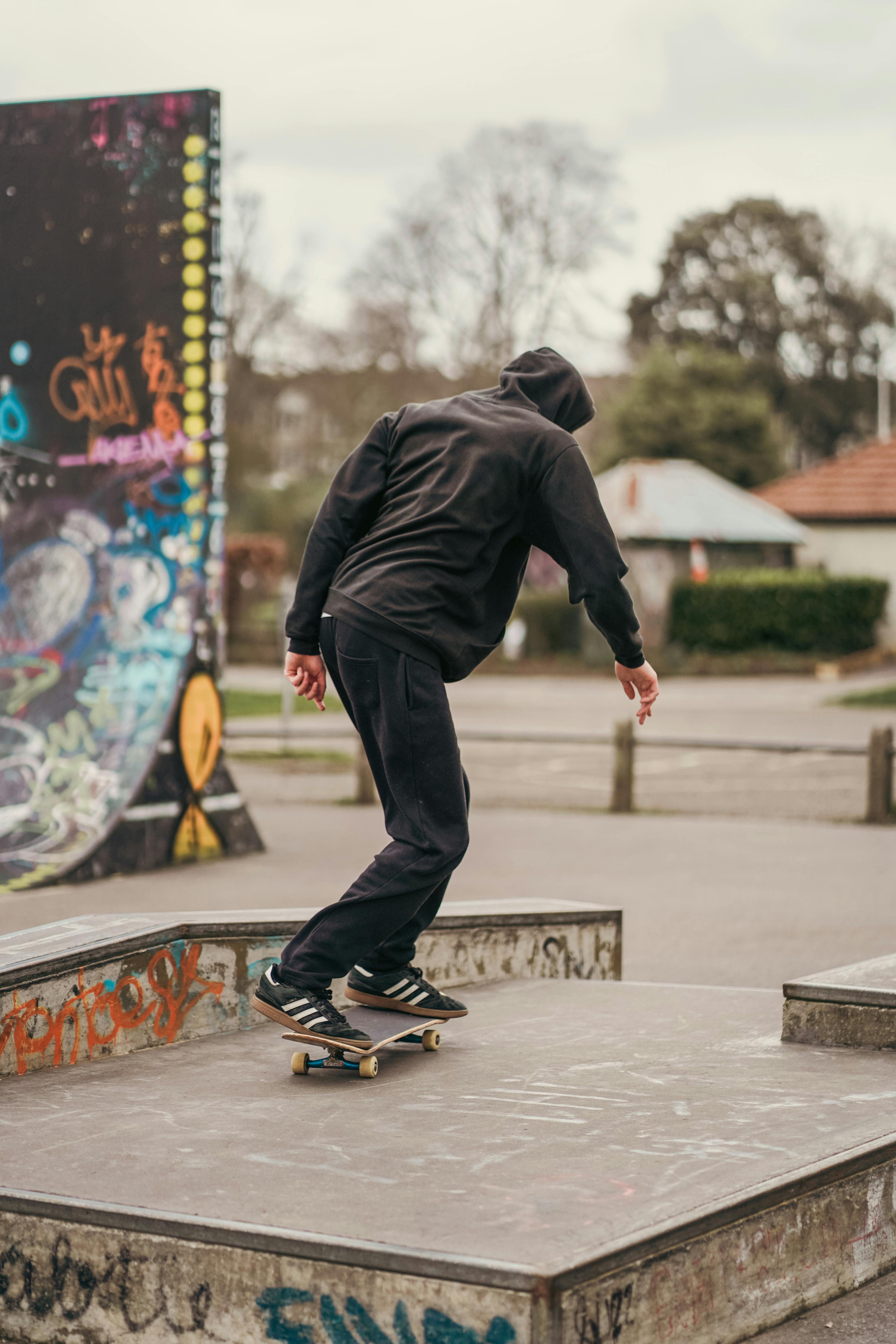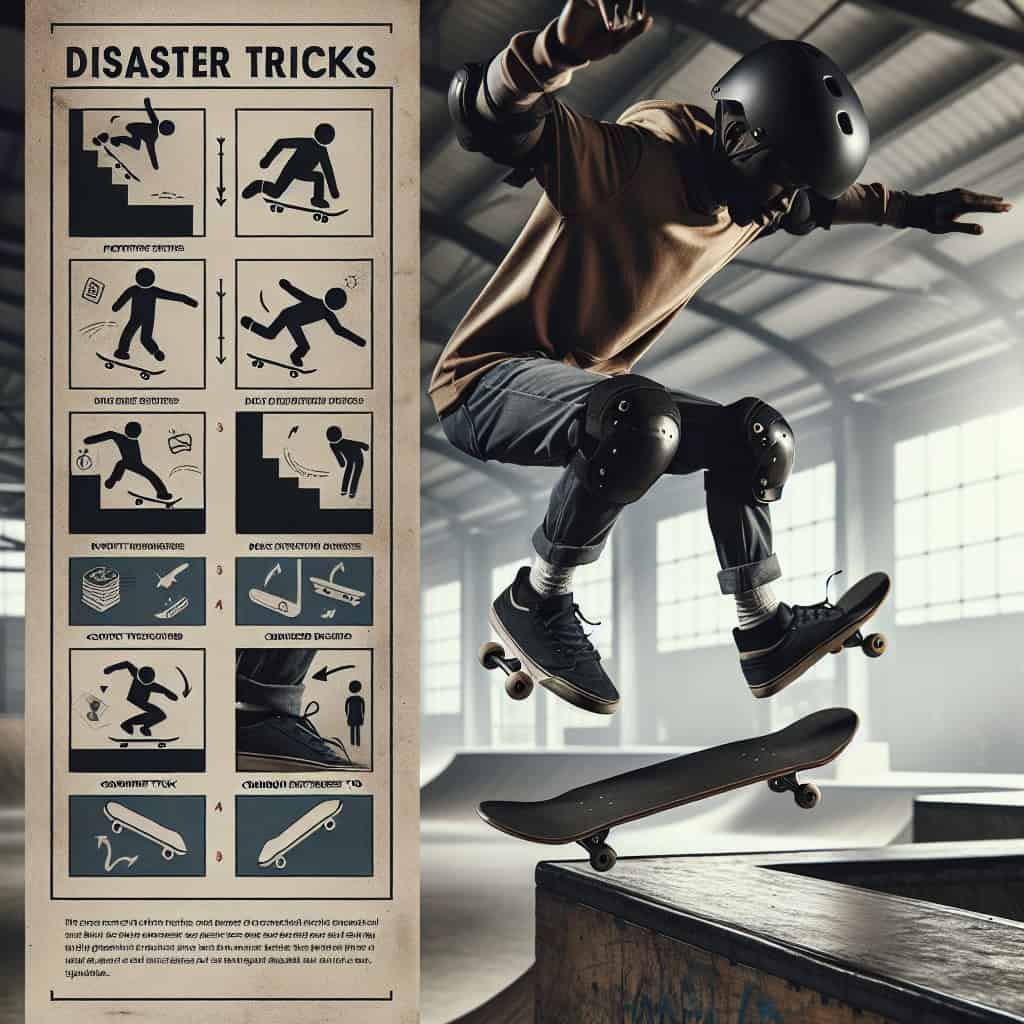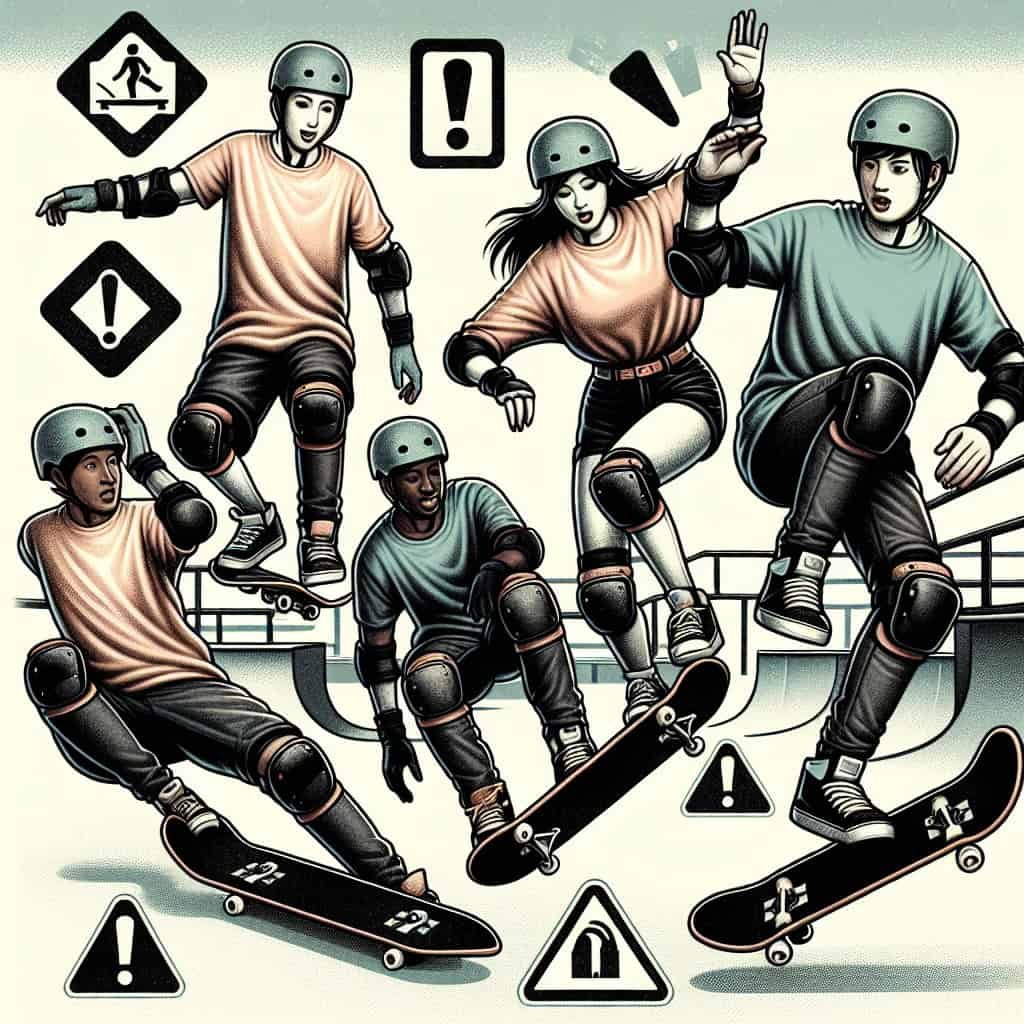You love the thrill of skateboarding and pushing yourself to learn new tricks, but you also want to make sure you’re staying safe while doing so. In this article, we’ll explore some key tips and techniques for safely practicing skateboard disaster tricks. From understanding the importance of protective gear to finding the right practice area, we’ve got you covered. So, grab your skateboard and let’s dive into the world of safe skateboarding!

Choosing the Right Skateboard
Consider Skateboard Size and Shape
When choosing a skateboard, it’s important to consider the size and shape that suits you best. Skateboards are available in various sizes, so you want to ensure that the dimensions of the board match your height and shoe size. If you’re a beginner, opting for a wider board will provide you with more stability, making it easier to learn the basics. Additionally, consider the shape of the skateboard deck. There are different shapes available, such as the traditional popsicle shape or the wider cruiser shape. Choose a shape that aligns with your intended style of riding.
Choose a Sturdy and Durable Board
Skateboarding can be quite demanding on your equipment, so it’s crucial to choose a skateboard that is sturdy and built to withstand the impacts of tricks and jumps. Look for boards made from high-quality materials such as maple wood, which offers excellent durability. Checking the weight limit specified by the manufacturer is also essential, especially if you’re on the heavier side. A well-constructed and durable skateboard will ensure that you can practice your tricks without worrying about frequent breakages or damage to the board.
Ensure Proper Truck and Wheel Size
The components of a skateboard, such as the trucks and wheels, play a significant role in your overall skateboarding experience. The trucks are the metal T-shaped parts that attach the wheels to the deck. Opt for trucks that match the width of your skateboard deck. Too narrow or too wide trucks can affect your stability and control. Likewise, selecting the right wheel size is important. Smaller wheels are generally better for technical tricks, while larger wheels provide more speed and stability for cruising. Consider your style of skateboarding and the types of tricks you plan to do when choosing the appropriate truck and wheel size.
Wearing Protective Gear
Helmet
Safety should always be a top priority when skateboarding, especially when attempting more challenging tricks. Wearing a helmet is essential to protect your head from potential injuries. Look for helmets specifically designed for skateboarding, as they offer better protection than regular bike helmets. The helmet should fit snugly on your head and have proper padding to absorb impact. Always ensure that your helmet is in good condition without any cracks or damage before each session.
Knee Pads
Knee pads are crucial for protecting your knees from falls and impacts. When attempting disaster tricks, falls are inevitable, and having knee pads can help prevent serious injuries such as scraped knees or even fractures. Look for knee pads that are comfortable, provide ample padding, and have secure straps to keep them in place during intense skateboarding sessions.
Elbow Pads
Just like knee pads, wearing elbow pads is an important safety measure. Elbow pads protect your elbows from injuries that can occur when landing on hard surfaces or during collisions. Choose elbow pads that fit comfortably and don’t restrict your movement. It’s important to keep your elbows protected, as any injuries in this area can hinder your progress and limit your ability to perform tricks.
Wrist Guards
Skateboarding often involves using your hands for balance and to break falls. Wearing wrist guards can protect your wrists from sprains, fractures, or other injuries that can occur from impact. Look for wrist guards that provide both support and flexibility. Make sure they fit properly and have a secure closure system to keep them in place during intense skateboarding sessions.
Protective Clothing
In addition to the essential protective gear mentioned above, it’s also important to wear appropriate clothing when skateboarding. Avoid loose or baggy clothing that can become entangled in the skateboard or obstruct your movements. Opt for clothes made from durable fabrics and consider wearing long sleeves and pants to provide some extra protection against falls and scrapes. It’s also a good idea to wear closed-toe shoes with a firm grip to ensure proper foot control and prevent accidents.
Selecting the Right Location
Skateparks
Skateparks are purpose-built facilities designed specifically for skateboarding, making them ideal locations for practicing tricks. These parks often feature a variety of obstacles, such as ramps, rails, and bowls, catering to different skill levels. Skateparks provide a controlled environment with smooth surfaces, allowing you to focus on perfecting your tricks without worrying about pedestrians or traffic. It’s important to familiarize yourself with the park’s rules and etiquette, as well as be mindful of other skaters sharing the space.
Empty Parking Lots
Empty parking lots can offer ample space and a smooth surface, making them suitable for practicing skateboard tricks, especially if you don’t have access to a skatepark. However, it’s important to choose parking lots that are free of cars and pedestrians to ensure your safety. Before using a parking lot, make sure you have permission or that it’s legal to use it for skateboarding. Keep in mind that the asphalt surface of parking lots may be rougher than skatepark surfaces, so adjust your technique accordingly.
Smooth Pavements
Smooth pavements with minimal cracks and obstructions can be great practice areas for beginner skateboarders. Look for quiet residential streets or low-traffic areas with smooth asphalt or concrete surfaces. When using pavements, be cautious of passing vehicles and pedestrians. Always prioritize your safety and choose locations where you can focus on your tricks without distractions.
Avoid Busy Streets
It’s crucial to avoid busy streets when practicing skateboard tricks. Busy streets pose a higher risk of accidents, with unpredictable traffic patterns and a lack of dedicated skateboarding space. It’s best to find alternative locations such as skateparks, empty parking lots, or smooth pavements, where you can skate safely away from traffic. Always prioritize your safety and choose locations that minimize the potential risks.
Warm-Up and Stretching
Dynamic Warm-Up Exercises
Before jumping into intense skateboard trick practice, it’s important to warm up your body to prevent injuries. Dynamic warm-up exercises help increase blood flow to your muscles and prepare your body for physical activity. Incorporate exercises such as jumping jacks, lunges, high knees, and arm circles to activate your muscles and get your heart rate up. Performing dynamic warm-up exercises for about 10 minutes before skateboarding can help improve your performance and reduce the risk of muscle strains or sprains.
Stretching Exercises for Flexibility
Stretching is essential for maintaining flexibility and preventing muscle tightness. After completing your dynamic warm-up, take a few minutes to stretch major muscle groups used during skateboarding, such as your legs, arms, and back. Perform static stretches, holding each stretch for about 30 seconds. Focus on stretches for your quadriceps, hamstrings, calves, shoulders, and wrists. Regular stretching can improve your overall range of motion and help prevent muscle imbalances that can lead to injuries.

Learning the Basic Techniques
Mastering Basic Tricks
Before attempting more advanced disaster tricks, it’s important to master the basic techniques. Start with fundamentals such as ollies, kickflips, and pop shuv-its. These tricks will help you develop the necessary control and coordination needed for more complex maneuvers. Take your time and practice these tricks repeatedly until you feel comfortable performing them consistently. It’s essential to have a solid foundation before progressing to more challenging tricks.
Practice Proper Foot Placement
Foot placement significantly affects your balance and control on the skateboard. Experiment with different foot positions to find what works best for you. For most tricks, you’ll want to have your front foot positioned diagonally across the skateboard, with your toes angled slightly towards the nose. Your back foot should be placed on the tail, perpendicular to the skateboard. Proper foot placement ensures stability and allows for efficient execution of tricks.
Focus on Balance and Posture
Maintaining balance and proper posture is crucial for executing tricks safely and effectively. Keep your body centered over the skateboard and distribute your weight evenly between your front and back foot. Engage your core muscles to maintain stability and control. Additionally, keep your knees slightly bent, which will provide greater shock absorption and help you adjust to uneven surfaces. Focusing on balance and posture will enhance your overall performance and reduce the risk of falls.
Progressing to Disaster Tricks
Start with Smaller Obstacles
When attempting disaster tricks, it’s important to start with smaller obstacles to gradually build your confidence and skill level. Begin with lower ramps or obstacles that you feel comfortable tackling. As you gain proficiency and become more comfortable with the basic techniques, gradually increase the difficulty of the obstacles you tackle. Progressing gradually will help you develop the necessary control, coordination, and confidence required for more advanced tricks.
Gradually Increase the Difficulty
As you become more proficient in executing disaster tricks, gradually increase the difficulty level by attempting tricks on bigger ramps or obstacles. This progressive approach allows you to develop and refine your skills over time, reducing the risk of injury. It’s essential to give yourself enough time to master each level of difficulty before moving on to the next. Rushing your progression can lead to frustration and accidents.
Learn from Experienced Skaters
Learning from experienced skaters can greatly accelerate your progression and help you safely practice disaster tricks. Seek out local skateboarding communities or skate parks where you can interact with more experienced riders. Observing their techniques, asking for tips, and receiving feedback can provide valuable insights and guidance. Listening to their advice and learning from their experiences will help you avoid common mistakes and enhance your skills more effectively.

Understanding Risk Factors
Be Aware of Potential Dangers
Skateboarding involves inherent risks, particularly when attempting disaster tricks. It’s crucial to be aware of potential dangers, such as falls, collisions, and impact-related injuries. Understanding the risks allows you to take precautionary measures and make informed decisions while practicing. Always prioritize safety, wear appropriate protective gear, and practice in controlled environments to minimize the chance of accidents.
Assess Personal Skill Level
It’s important to assess your individual skill level honestly. Be aware of your limitations and avoid attempting tricks that surpass your abilities. Overestimating your skills can lead to unnecessary injuries. Focus on mastering the fundamentals and gradually progressing to more challenging tricks as you become more comfortable and confident. Understanding your skill level will enable you to set realistic goals and practice safely.
Consider the Consequences
Skateboarding disaster tricks require precision and control. Before attempting any trick, consider the potential consequences of failure. Visualize the worst-case scenario and assess whether you’re mentally and physically prepared to handle it. It’s important to strike a balance between pushing your limits and ensuring your safety. Always prioritize caution and make responsible decisions to minimize the potential risks.
Realistic Expectations
Patience and Persistence
Skateboarding is a skill that takes time and practice to master. It’s essential to have patience and persistence throughout your skateboarding journey. Mastery of tricks and techniques doesn’t happen overnight. Embrace the learning process and be prepared to put in the time and effort required. Celebrate small victories along the way, and remember that progress comes with consistent practice and dedication.
Set Achievable Goals
Setting achievable goals is crucial for maintaining motivation and tracking your progress. Start with small, attainable goals and gradually build upon them. For example, aim to consistently land a specific trick a certain number of times before moving on to the next challenge. By setting realistic goals, you’ll experience a sense of accomplishment and stay motivated to continue improving.
Learn from Failures
Failure is a part of the learning process in skateboarding. Embrace your failures as opportunities to learn and grow. When faced with setbacks, assess what went wrong, and analyze your technique. Use each failure as a stepping stone toward improvement. Learning from your mistakes will help you refine your skills, build resilience, and ultimately achieve success.

Practice in Controlled Environments
Use Foam Pits or Resi Ramps
When progressing to more advanced disaster tricks, it’s beneficial to practice in controlled environments such as foam pits or resi ramps. These setups offer a softer landing surface, reducing the impact on your body in case of falls. Foam pits filled with foam cubes and ramps with a special rubberized surface called “resi” provide added safety and confidence while pushing your limits. Utilizing these controlled environments allows you to focus on perfecting your technique without the fear of severe injuries.
Gradually Transition to Real Obstacles
As you gain proficiency and confidence in performing disaster tricks, it’s essential to gradually transition from controlled environments to real obstacles. Start by attempting tricks on lower ramps or smaller obstacles similar to what you practiced in controlled environments. With each successful attempt, gradually increase the height or difficulty level of the obstacles. This progressive transition ensures that you can apply your learned skills to real-world situations while minimizing the risks associated with attempting tricks on unfamiliar terrain.
Knowing When to Seek Help
Injuries and Rehabilitation
Skateboarding carries inherent risks, and injuries can occur even with proper precautions. If you experience any injuries while skateboarding, it’s important to seek appropriate medical attention and follow a proper rehabilitation plan. Injuries should not be taken lightly, and proper healing is essential to avoid long-term complications. Consult with a healthcare professional experienced in sports injuries and follow their guidance for a safe and speedy recovery.
Working with a Skateboarding Coach
If you’re looking to progress in your skateboarding skills and refine your disaster tricks, working with a skateboarding coach can be immensely beneficial. A qualified coach can provide personalized guidance, identify areas for improvement, and help you develop a structured training plan. They can also provide valuable insights into proper technique, offer support, and help you overcome any mental barriers. Working with a coach can accelerate your progression while ensuring you practice safely and efficiently.
In conclusion, practicing skateboard disaster tricks safely requires careful consideration of various factors. Choosing the right skateboard, wearing proper protective gear, selecting appropriate locations, warming up and stretching, mastering basic techniques, and understanding risk factors are all essential steps to ensure a safe and enjoyable skateboarding experience. Remember to set realistic expectations, practice in controlled environments, and know when to seek help. With patience, perseverance, and a commitment to safety, you can confidently progress in your skateboarding journey and achieve your goals. Happy shredding!

